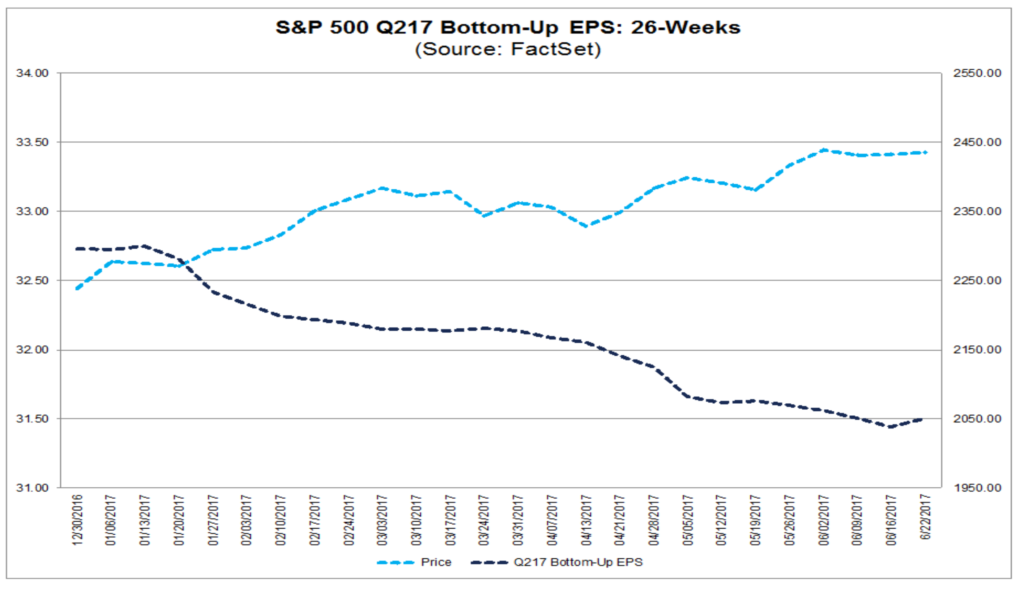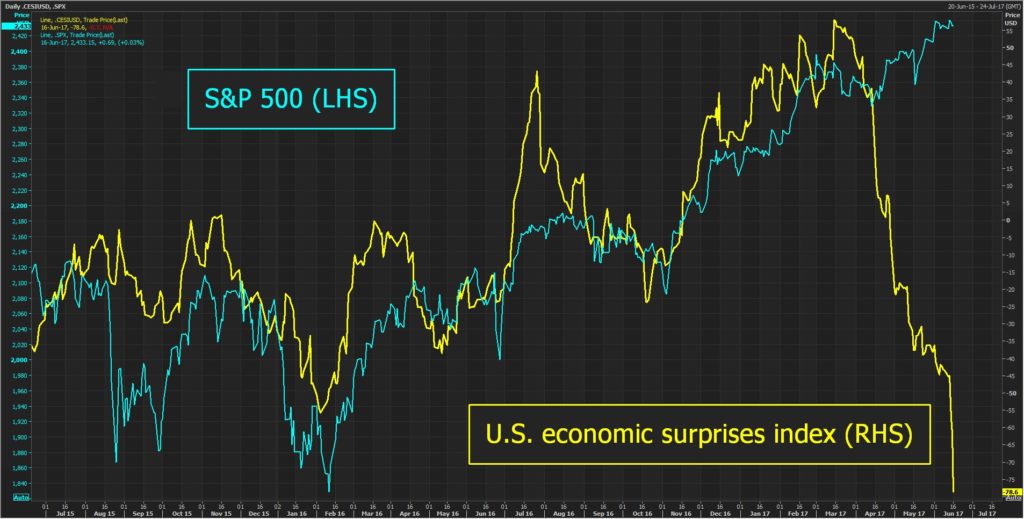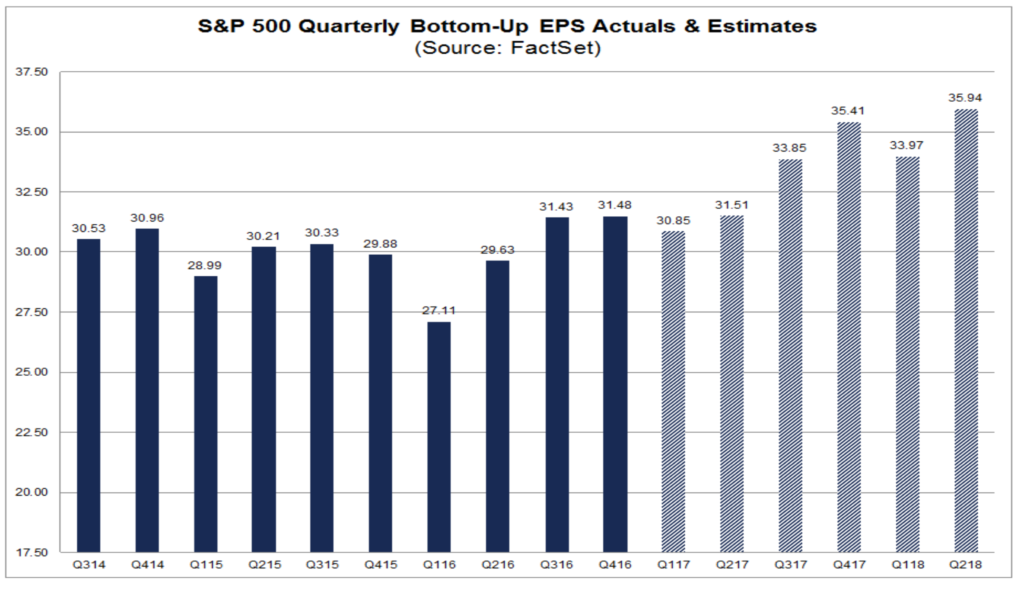It’s More Than Just Wall St Oil Analysts Asleep at the Forecasting Switch
DOWNLOAD THIS WEEK’S ISSUE
The full content of The Monday Morning Kickoff is below; however downloading the full issue provides detailed performance tables and charts. Click here to download.
Yes, folks, we’re almost halfway through the year. Just five trading days this week and we’ll close the books on the second quarter and the first half of 2017. The good news is next week is a short one with the upcoming July 4th holiday (one of our favorites here at Tematica), but soon after the 2Q 2017 earnings bonanza will begin.
We’ve been getting some drips and drabs of earnings reports over the last few weeks, but we’ll see that pick up dramatically even before Alcoa (AA) reports its quarterly result on July 17. One quick comment on the 2Q 2017 earnings calendar, given the timing of the July 4th holiday, odds are we will once again see a compressed earnings cycle like we did with 1Q 2017 earnings due to the Easter holiday. If you forgot, it was fast and furious, especially on Thursdays and we don’t expect that to change this time around. More on that once we clear the upcoming holiday.
With a handful of days left until we shut the books on June and 2Q 2017, all three major stock market indices are up more than 8 percent year to date, with the Nasdaq Composite Index up an impressive 16.3 percent as of Friday’s market close. Here’s the thing, more than half of the returns occurred during 1Q 2017, with 10 percentage points of the Nasdaq’s climb happening during those first three months of the year. Over the last several Monday Morning Kickoffs we’ve shared a number of views as to why this was likely to happen, including the notion that much like rubber bands, valuations can only going to stretch so far — a topic we’ll be revisiting later this week during our next Thematic Summit for our Tematica Professional Members.
Crude Oil Slips into Bear Market Territory
Hands down, the biggest news last week was had in the energy “sector” as oil prices continued their move down, officially moving into bearish territory. Tematica’s Chief Macro Strategist Lenore Hawkins and Tematica’s Chief Investment Officer discussed this on last week’s podcast as well as several other items that continue to fetch their interest – hint: Amazon’s (AMZN) latest moves with Whole Foods (WFM) and Nike (NKE) was one of them as Amazon continues to expand the number of thematic drivers behind its businesses. If you missed the podcast, you can click here, but we do recommend you subscribe on iTunes.
Back to the slump in oil prices… Crude’s slide is due not only to growing supply but also weak demand. Not to sound like a know it all, but supply-demand dynamics are pretty much economics 101, and when we see ramping US supply alongside a slowing domestic economy, it hasn’t been hard to guess where the price of oil is headed. The proverbial second shoe to watch is earnings. We mention this because, according to FactSet, the energy sector is expected to be the biggest contributor to EPS growth for the S&P 500 in the current quarter. With oil at just over $43 per barrel, well below the $51 level it averaged in 1Q 2017 and the $52 mean estimate for the average price of oil for Q2 2017, we’ve started to see Wall Street respond with price target and EPS cuts.
As those analysts re-calculate their forecasts, we’re likely to see more negative revisions for energy earnings for the current quarter as well as the back half of 2017.
Why?
Because the current data set does not point to a pronounced pickup in the economy near-term, which now means 3Q 2017. The New York Fed’s Nowcast for 2Q 2017 GDP hit 1.9 percent last week with 3Q 2017 falling to 1.5 percent. The Atlanta Fed’s next update doesn’t hit until later today, but the vector and velocity of its forecast have also been down over the last several weeks. While we often tend to poke some good-natured fun at the Atlanta Fed’s forecasting skills, we would be surprised to see an upward revision given the strong rollover in the Citibank Economic Surprise Index.
If you’re wondering if the consensus GDP expectations for 2Q 2017 and 3Q 2017 have come down in tandem with those for those two Fed banks, the answer would be a resounding no. Per The Wall Street Journal’s Economic Forecasting Survey, the consensus view for 2Q 2017 GDP across more than 60 economists is still sitting at 3.0 percent. The same group sees 3Q 2017 at 2.5 percent.
It seems it’s more than Wall Street oil analyst asleep at the forecasting switch.
“The level of complacency about where markets are today is pretty scary. People are just sort of assuming it’s OK, that it is what it is, and I have to say that I’m a little bit concerned about it.
– Jon Winkelried, CEO of TPG Capital
 Given the speed of the economy and ramped up US supply, we don’t see any near-term reversal for oil prices. Moreover, as those revisions happen, the ripple effect will bring down expected earnings growth rates for the S&P 500 as well because the energy sector was forecasted to be the biggest earning contributor for both 2Q 2017 as well as for all of 2017.
Given the speed of the economy and ramped up US supply, we don’t see any near-term reversal for oil prices. Moreover, as those revisions happen, the ripple effect will bring down expected earnings growth rates for the S&P 500 as well because the energy sector was forecasted to be the biggest earning contributor for both 2Q 2017 as well as for all of 2017.
The bottom line is there are several sets of expectations that are poised to be moved lower over the coming weeks, and it’s going to make for an interesting 2Q 2017 reporting season. That’s especially true for oil companies, but also for the overall market as well. We suspect corporate outlooks are likely to range from being cautiously optimistic for the second half of the year to guidance being reigned in, which in our view is far more likely given the push out in Trump policy timing as well as all of what we’ve discussed above.
“Although the consumer seems to be growing at a relatively good pace, the corporate side just seems to be in that uncertain phase where they want more certainty in the world before they make the next decisions.” — Tom Montag, COO Bank of America (BAC)
What this means is there is a far greater probability of volatility returning to the market as these revisions are had. If we’re right and EPS expectations for the S&P 500 get trimmed back, we’ll be faced with one of two things:
- Either the market becomes that much more expensive than the 17.9x multiple on expected (but still yet to be revised lower) 2017 EPS it closed at on Friday.
- Or investors will re-asses the market multiple, likely pushing it lower, as those EPS cuts are made.
It’s a simple rule, but investors pay up for growth but aren’t willing to pay up quite as much when growth is slower than expected.
Washington Never Seems to Shy Away from the Spotlight
Giving all of the earnings pressures a helping hand, we’ve got more DC drama ahead in the coming weeks. First, Gary Cohn, director of the National Economic Council, doesn’t expect the White House to get a tax bill in front of Congress until September. Not much of a shocker, and we have been saying we don’t see much happening on this front until after the 2017 elections.
Then there is the upcoming health care battle in the Senate and the rest of the Trump agenda (repatriation, tax reform, infrastructure), which as we’ve been saying is far more likely to begin anew after the 2017 elections. A draft of the Senate’s healthcare bill was released last week, and it’s been indicated a vote could occur before the July 4 recess. We’ll see if this happens, but if it doesn’t, it means a vote will likely come just as 2Q 2107 earnings really heats up.
To round out the Washington focus, it’s looking like Senate Republicans are planning for a July vote to raise the debt ceiling. While the calendar has yet to be set, given how July 4th falls, odds are this vote will also happen smack dab in the middle of 2Q 2017 earnings season. Making it potentially even more complicated than we’ve seen in the past, there is growing talk that the debt ceiling should be raised by an amount large enough to preclude another vote for several years. This could prove to be a bigger challenge, but again, for now, it’s just talk and we’ll get some greater clarity after the July 4th holiday.
Normally there is some back and forth squabbling across the aisles in Congress, but let’s remember we have elections in just few months. With Trump’s approval rating in the tank, odds are the Dems are going to pull out all the stops, and we could see this begin to take shape with the debt ceiling vote.
Bottomline Impact on Earnings and Washington Drama
All told, much of this is likely to be political noise, but depending on the tone of 2Q 2017 earnings — which again need to be adjusted for not only the impact of falling oil prices, but also slowing GDP relative to expectations — it could add to what is likely to be a volatile ride in the coming weeks.
While many will be watching 2Q 2017 results over the coming week, we hear at Tematica will also be assessing the potential adjustments to 3Q 2017 and 4Q 2017 earnings prospects. As you can see in the chart below, currently the herd is calling for The S&P 500 EPS to grow more than 11 percent in the second half of 2017 compared to the first half. Keep in mind, the average growth in second half earnings for the S&P 500 compared to the first half over the 2010-2016 period was 5.6 percent.
The Week Ahead
As we mentioned several paragraphs earlier, the close of this week shuts the book on June and 2Q 2017, but we’ll continue to get more data over the next few weeks that will help fill in the blanks for the global economy’s speed during the quarter. This week we’ll get the next iteration of the Durable Goods Orders, Consumer Confidence, Personal Income & Spending as well as the usual weekly reports, including mortgage applications and jobless claims. We’ll also get a number of regional Fed reports from the Dallas, Richmond and Chicago Feds as well as the Chicago Fed’s National Activity Index. Should the data perform like Friday’s June Flash PMI released by Markit Economics that showed manufacturing activity at a 9-month low and services activity at a 3-month low, odds are we’re going to see even further downward GDP revisions by both the Atlanta Fed and New York Fed.
Turning to this week’s conferences, here are the ones we’ll be watching and the corresponding exchange traded funds (ETFs) that are likely to be affected:
- JPMorgan Energy Equity Investor Conference – Energy Select Sector SPDR Fund (XLE) and Vanguard Energy ETF (VDE)
- Credit Suisse CEO/CFO Leisure Sector Conference – PowerShares Dynamic Leisure and Entertainment Portfolio ETF (PEJ)
- Tarsier Capital Management MicroCap Conference – iShares Micro-Cap ETF (IWC)
- Sanford C Bernstein Future of Media Summit – PowerShares Dynamic Media Portfolio ETF (PBS)
As far as earnings reports to be had this week, we’ve once again provided a thematic listing of what’s ahead below, but we’ll be looking to learn from Nike (NKE) it’s rational for linking up with Amazon as well as what McCormick & Co. (MKC), Darden (DRI) and General Mills are seeing in the way of food deflation and eating at home vs. eating out. While it’s not reporting earnings this week, United Parcel Service (UPS) is conducting a non-deal roadshow in Europe hosted by RW Baird and given its role in the Connected Society as well as a read on the overall economy we’ll be sifting for clues on both.
All in all, it’s looking to be a busy week ahead of the July 4th holiday, but we’ll there to guide subscribers to Tematica Investing through it.




